Bollards for the fence - an indispensable attribute of any
When we look at the fence, we first of all assess the quality and appearance of the spans, its exact, even line, reliability. And, maybe, we do not even realize that all this is provided and begins with ordinary columns.
Construction does not do without columns one fence. They represent a solid foundation on which the longevity of the whole structure depends.
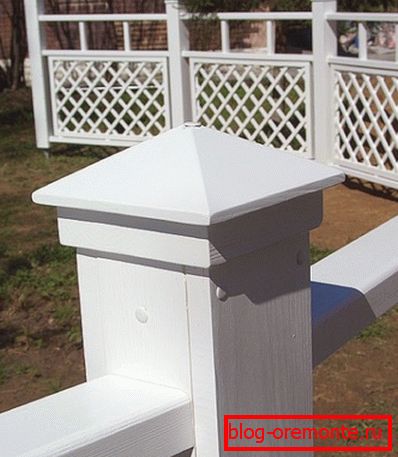
It is very difficult to make such bollards with your own hands, use ready-made proposals that will provide a beautiful view of the fence as a whole and will significantly reduce the time of its construction.
Reliable base

Reinforced concrete bollards sold in hardware stores
Of course, we think of the fence as a single structure in which everything must ideally match each other.
However, the basis of this choice can serve as the pillars of the following types:
- Wood. It is very tempting to use wooden posts - a long-standing and very common building material. But there are three factors to keep in mind. First, not every tree species will withstand 10 years of continuous exposure to adverse weather conditions. Birch and pine will stand in the fence no more than 3 years. Only oak and beech can give a maximum period. Secondly, any tree species will need to be treated with an antiseptic, otherwise no oak can resist even insects. Well, and, thirdly, high-quality wooden poles for the fence is much more expensive than all the others.
- Asbestos cement. This fastener is much cheaper than wooden, does not require any treatment. But there is one drawback - it is very difficult to fasten lags to the asbestos-cement pillars, the design becomes unusable. Therefore, you have to invent your own, external, means of fasteners.
- Reinforced concrete. The most reliable fence posts. The price in terms of long service life is one of the most favorable.
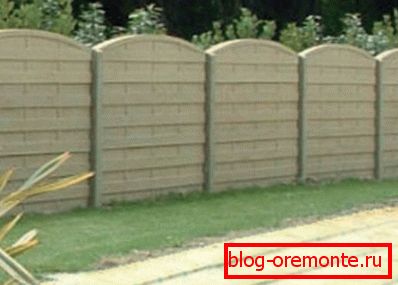
More “advanced” column structures already have grooves to the left and right of the fence line, which, after being installed, the fence itself can be assembled from individual slabs in just a couple of hours.
- Metallic. It is the metal that is the main material from which the fence posts are made. If you do not forget that the metal is susceptible to corrosion, which means that every spring you have to start with painting the metal pillars of your fence, then such pillars are an excellent reliable and inexpensive choice.
- Brick. As a matter of fact, these are all the same metal pillars in the core, but reinforced with bricks. Brick gives such a pillar a beautiful appearance, but also significantly increases its price and weight. The use of brick pillars requires very careful preparation of the foundation.
Helpful advice! Where there are pillars for the fence, there is the need for earthworks, the creation and concreting of pits under the pillar. Be sure in this regard, take into account the depth of soil freezing in your area. The depth of the pit under the pole should be 30-40 cm below the depth of freezing. Otherwise, after the very first winter, the fence will “lead” you.
Installation of fence posts
The installation of the fence posts can be described in literally three sentences. First, we make a recess, it will turn out - with a drill, no - then manually. We insert the pillar, aligning it strictly vertically and not forgetting to use for this purpose reliable stones as supports below the ground level.
Fill the deepening concrete. That's all, perhaps, still waiting for 2-3 days for the concrete to set.
But this process is much more complicated if we take into account the following factors that significantly affect the entire course of work.

Ready-made metal columns from manufacturers are already well-thought-out structures, for the use of which, detailed instructions must be attached.
Present progress
The installation of the bars is significantly affected by the following:
- The nature of the soil. From the point of view of the master who installs the fence, the ground can be divided into 2 types - letting moisture through itself or literally floating in it, not letting it through. The latter is also called “heaving”. These include, first of all, clay. Retention of moisture in the ground, perhaps, would not be of great importance if it were not for the cold. Cold causes the formation of ice in the heaving ground, which literally pushes the bar out. Hence the conclusion. If you are unlucky with the ground, you will have to remove it all around the post and replace it with a well graded down, ideal for such purposes.

Photo 5. Installation of the column requires a good equipment - no level, adjusted guides and formwork can not be done here
- Depth of soil freezing. All work may be useless if the hole under the column is less than the depth of soil freezing. The pit should be 30-40 cm below the maximum depth of freezing. The very same column does not necessarily install to the bottom of the pit.
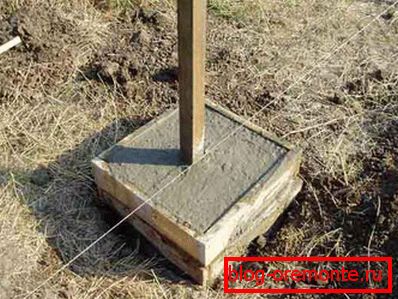
Photo stiffening concrete in the pillar. Be sure to let the concrete dry for 2-3 days.
- Often, if the ground is sufficiently reliable, then it is generally possible to do without concreting the fence posts. Masterfully and vertically made by the drill hole will save a lot of time and resources. Actually, you can always see this technology at world-class ski competitions. Oh, what loads the flags are - any column of the fence does not envy, but the flags are “dead in the hole”. But all the same it is necessary to leave one's place, as literally in a few minutes a special portable auger again makes a hole in the rock and sets a flag into place. But the breed is mostly rocky.
Helpful advice! We can say that high-quality drainage around the column is the key to the success of the whole business. Pay attention to this stage of work. Preventive drainage up to 30 cm radius from the center of the column does not interfere with performance, even if the ground does not require it or you did not use concrete and inserted a column into the recess made by the drill.
Very important note
In no case do not allow moisture to get inside the columns. In winter, the moisture simply breaks down the asbestos cement and wooden posts. Metal, most likely, withstand visible damage, but they are deformed under the ground and lose their stability.
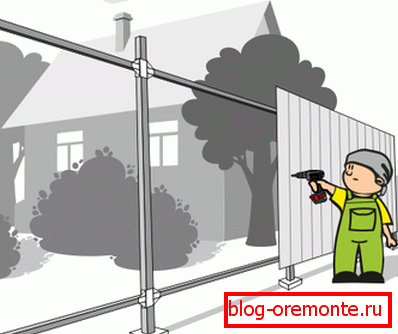
Column for the fence - only one of the components of the structure with the use of corrugated
The best solution to protect against moisture from the outside is drainage, and from the inside of the column - using caps on top. When purchasing hollow columns with a hole "to the stars", be sure to take care of reliable caps in advance.
Conclusion
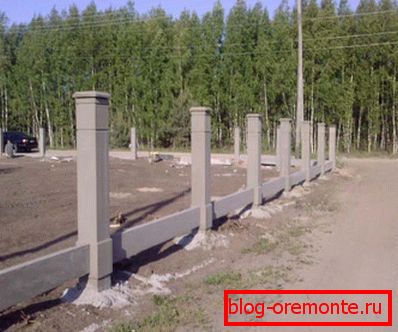
Extremely important when installing the pillars is the exposure of their exact and equal distance from each other. This can help special lower spacer horizontal panels.
The installation of the fence consists of a whole series of decisions made - the design study, the choice of material, height, length and the order of installation. In this chain of decisions one of the main things will be - the choice of fence posts. It is the choice of pillars and the reliability of their installation that will determine in the future the reliability of the whole structure. In the presented video in this article you will find additional information on this topic.